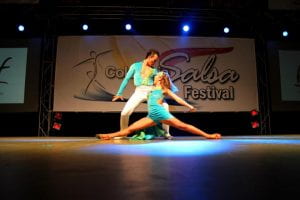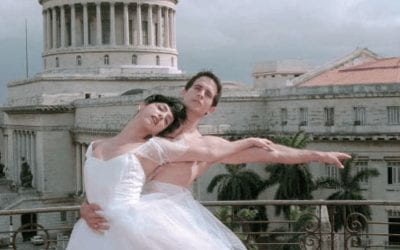Salsa Dancers from Cali, Colombia Hop Onto the World Stage

“David and Paulina – 2013 Colombia Salsa Festival” by David and Paulina / CC by 2.0
Once, people of the ocean, from the coast, moved to the valley, hoping to put the Andes between them and Colombia’s decades of killing.
Now, 28 of their grandchildren stood on the cusp of history.
No, they danced on it.
Their $2-a-week-salsa dance classes and rehearsals at Luis Carlos Caicedo’s Nueva Dimension academy on the gritty outskirts of Cali had paid off. The group of grade-schoolers and teens had scored an invitation to participate in the 9th annual West Coast Salsa Congress in Los Angeles this spring.
Without knowing it, they were characters in a chapter still being written into the annals of dance. It’s a story of a culture’s global currents, as hard to follow as the flights of some migratory birds.
The piston-footed, below-the-waist style of dancing salsa developed during the last 40 years in Cali, Colombia’s southwestern city of two million-plus, has been dropping jaws since 2005, from Wellington, New Zealand, to Salt Lake City.
The first two years of the World Salsa Championships, held in Las Vegas, aired on ESPN International and organized by a group called the Salsa Seven, produced two first-place and two top-three finishers from Cali.
Judges at those events were more than impressed.
They were beginning to grouse about how to score the caleños, since their style was completely different from the Cuban and Puerto Rican-influenced steps they had seen.
The same thing has been happening at qualifying rounds for the 2007 championships, slated for Dec. 12-16 at Walt Disney World Resort in Orlando, Fla.
How did this rhythm, sprung from 1970s ferment among Caribbean populations in urban barrios, land in an Andean country’s tropical valley crisscrossed by sugar cane fields? The answer is in the very legs of those kids, a pair of whom wound up qualifying for the 2007 championship based on their L.A. performance. Or better, it’s in the legs of their grandfathers and grandmothers.
The forerunners of today’s acrobatic cadences were actually U.S. sailors who landed on Colombian shores in the 1940s, showing the Charleston and other steps to black Colombian bar-hoppers in Buenaventura, the country’s Pacific port city. The porteños adapted those hops, leaps and flips to Caribbean music, particularly Cuban sounds.
Three decades later, violence pushed the children of those dancers to Cali. The migration from Buenaventura and surrounding areas never stopped, producing one of the largest urban slums in Latin America—Aguablanca.
New York and Puerto Rican salsa also hit Cali in the 1970s, and the city moved to the sound of timbales, congas and brass. With drug cartel financial backing in the 1980s, the music became homegrown. Up to 100 salsa orchestras were formed, seemingly on every corner.
Cali dubbed itself “The Salsa Capital of the World.” The annual December fair became the city’s signature event, as well as a place to pass down steps from generation to generation. Tens of thousands still meet during the week-long bacchanal, trading salsa records and dancing to local and international bands.
If a dance historian was to look for clues about how Cali’s frenetic dance style developed during these decades, he or she would also find that someone at some point discovered that boogaloo, a fusion of rock and Latin percussion, was a real blast to move your feet to if you put the record player on 45 r.p.m. instead of 33 1/3. Add that to the steps originally brought ashore via the feet of sailors, and you have today’s salsa cadence.
Now it’s the children of the urban slum Aguablanca who keep alive Cali’s particular style of salsa dancing, athletic below the waist, seemingly twice as fast as the styles practiced in New York, Los Angeles and the Caribbean, and lacking in twirls and flourishes.
Dancers worldwide are taking notes, says Albert Torres, a member of the Salsa Seven and the driving force behind the world championships. He shows videos of caleños from the first two years at qualifying rounds from Sydney, Australia to Goteborg, Sweden, and everywhere sees the same “What the heck is this?” look on the faces of dancers waiting to compete. The success caleños have seen, combined with the growth of the championships, is leading thousands in Cali to dream of hopping and stepping out of misery.
Riding the wave of popularity that dance competitions have enjoyed worldwide, the event’s third year promises to field competitors from more than 35 countries, after launching in 2005 with 12. The Salsa Seven has picked up contracts with ESPN and its parent company, Disney, along the way.
Still, it’s the dancers from Cali, says Torres, who are “the future of salsa.”
In a phone interview days before his group’s trip to L.A., Caicedo said that community raffles, local performance benefits and family loans provided travel funds. He observed that many of the kids had never seen the ocean, even though their parents or grandparents were from the coast. Decades later, salsa dancing was returning 28 boys and girls to the Pacific Ocean, following the flow of global cultural currents, in reverse.
Related Articles
Sacred Dance in the Peruvian Highlands
Long ago, a young shepherd named Marianito Mayta lived in the mountains above Mahuayani, caring for his aging father and tolerating the abuse of his lazy older brother. One day, a boy appeared who began to help Marianito with his chores. The Ocongate priest soon learned of this strange boy, whose white garments never ripped or stained, and, accusing him of stealing clothing from the church’s saints, decided to catch the rogue. …
Knowledgeable Bodies: Basque Traditional Dance and Nationalism
Imagine you are vacationing on the beach in Spain. What if you step out of your hotel on the first morning and see masses of people swarming toward you, brandishing flags and shouting in a language you don’t understand, as masked policemen clad in black and red jump suits and big black boots encourage orderl? Down at the plaza, silent attention to speeches alternates with loud chanting. Fists jut into the air, unmoving. …
Más Allá de los Clichés: Dance and Identity in Cuba
In 1955, the prolific Cuban scholar and ethnologist, Fernando Ortiz, claimed “dance is the principal and most enthusiastic diversion of the Cuban people, it is their most genuinely indigenous production and universal exportation.” Dance may not be the Cuban diversion, but the identification of Cuba with dance certainly surfaces in the popular imagination—most recently in Hollywood’s Dirty Dancing: Havana Nights, and decades …




